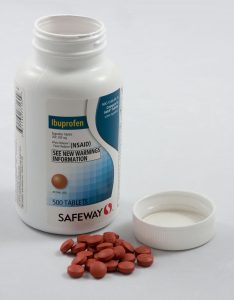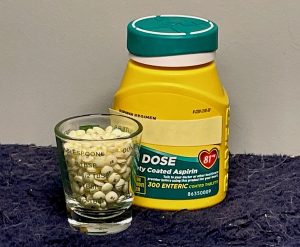11.3 Non-Narcotic Analgesics
Non-narcotic analgesics, often referred to as non-opioid analgesics, include acetaminophen and nonsteroidal anti-inflammatory drugs (NSAIDs). These are only effective for mild to moderate pain and are often the first step for pain control. The advantages of these medications is that they are inexpensive, not addictive, and often available over the counter, which means that a prescription is not required.
Acetaminophen
Acetaminophen (Tylenol) inhibits the synthesis of prostaglandins, which may serve as mediators of pain and fever primarily in the central nervous system. It is used to treat mild pain and fever but does not have anti-inflammatory properties. Acetaminophen also does not have some of the side effects common to NSAIDs, such as stomach upset. It is not related to aspirin, which will be discussed later, so can be taken by individuals who are allergic to aspirin. There are a number of different types of acetaminophen available on the market, and two of those are shown in Fig. 11.4.

Nonsteroidal Anti-Inflammatory Drugs (NSAIDs)
Nonsteroidal anti-inflammatory drugs (NSAIDs) have an analgesic effect, as well as antipyretic and anti-inflammatory actions. Some, such as aspirin, also have an antiplatelet effect. Aspirin and other NSAIDs relieve pain by inhibiting the biosynthesis of prostaglandins by different forms of the COX enzyme. COX-2 inhibitors, which are listed below, are different in that they are selective and only inhibit the COX-2 enzyme.
There are also possible side effects to taking NSAIDs, and these can vary depending on the type of NSAID, duration of use, and the patient’s current condition. As a result of the inhibition of COX by NSAIDs, there is also decreased protection of the stomach lining, and gastric irritation and bleeding may occur when these medications are taken. All NSAIDs except aspirin also increase the risk of heart attack, heart failure, and stroke. These can be fatal, and the risk is higher if the patient takes more of the medication than is directed or takes it for longer periods of time.
NSAIDs are used to treat various conditions, including the following:
-
- Osteoarthritis
- Rheumatoid arthritis
- Bursitis
- Tendinitis
- Gout
- Migraine headaches
- Dysmenorrhea
Key Concept
Examples: celecoxib (Celebrex), ibuprofen (Advil, Motrin)
Examples of NSAIDs (WebMD, 2023):
- celecoxib (Celebrex)
- diclofenac (Cataflam, Flector, Voltaren)
- etodolac (Lodine)
- fenoprofen (Nalfon)
- ibuprofen (Advil, Motrin)
- indomethacin (Indocin)
- ketoprofen (Ketofen, Anafen)
- ketorolac (Toradol)
- naproxen sodium (Aleve)
Ibuprofen
Ibuprofen (Advil, Motrin) inhibits prostaglandin synthesis. It is used for mild to moderate pain and is also an antipyretic with anti-inflammatory effects. Ibuprofen is used to treat common disorders, including rheumatoid arthritis and osteoarthritis, and pain associated with dysmenorrhea. It is safe for adults and for infants six months of age or older. Ibuprofen is sold under different trade names and is available in combination with other medications as well, such as cold medications. One option is shown in Fig. 11.5.

Ketorolac
The NSAID ketorolac (Toradol) is commonly used for “breakthrough” pain that occurs during the treatment of severe acute pain being treated with opioids. It is often given in conjunction with certain narcotic medications when those alone do not relieve the patient’s pain, and the pain “breaks through” the analgesic effect of the narcotic. Ketorolac inhibits prostaglandin synthesis and is indicated for the short-term management (up to five days in adults) of moderate to severe acute pain that requires narcotic analgesic medication.
Celecoxib
Celecoxib (Celebrex) is a COX-2 inhibitor and specifically inhibits the enzyme COX-2 that is required for the synthesis of prostaglandins. Celecoxib is often used to treat the pain associated with osteoarthritis, rheumatoid arthritis, and ankylosing spondylitis. It also relieves the pain associated with dysmenorrhea.
Acetylsalicylic acid and Other Salicylates
Acetylsalicylic acid (Bayer Aspirin, Ecotrin, Empirin) falls under a subcategory of NSAIDs called salicylates (Healthline, 2022). In some counties the generic name is also know as aspirin. Salicylates, which are derived from salicylic acid, are a group of chemicals that can be found naturally in plants and synthetically in medications such as aspirin (Healthline, 2022).

Other salicylate medications:
-
- diflunisal (Dolobid)
- magnesium salicylate (Doan’s)
- salsalate (Salsitab)
All salicylates have three therapeutic functions: analgesic, anti-inflammatory, and antipyretic. Aspirin shares these therapeutic functions by inhibiting the production of prostaglandins, but it also has a fourth therapeutic action that is unique and not shared by other salicylates—an antiplatelet function. This means it decreases platelet aggregation and can be taken daily to reduce the risk of heart attack and stroke. Aspirin is safe for adults and children older than 12 years of age.
The video below discusses the development of aspirin, how it was historically used, and how we currently use it in health care.
(TED-Ed, 2017)
Key Concept
Children and teenagers should not take aspirin to treat chickenpox or flu-like symptoms because of the risk of Reye’s syndrome. Reye’s syndrome primarily occurs in children in conjunction with a viral illness. It can cause symptoms such as persistent vomiting, confusion, or loss of consciousness, and requires immediate medical attention.
Table 11.1. Common Non-Narcotic Medications
| Generic Name | Trade Name | Reason for Administering |
| acetaminophen | Tylenol | Mild to moderate pain, fever |
| celecoxib | Celebrex | Mild to moderate pain, inflammatory conditions |
| diclofenac | Cataflam, Flector, Voltaren | Mild to moderate pain, inflammatory conditions |
| etodolac | Lodine | Mild to moderate pain, inflammatory conditions |
| fenoprofen | Nalfon | Mild to moderate pain, inflammatory conditions |
| ibuprofen | Advil, Motrin | Mild to moderate pain, inflammatory conditions, fever |
| indomethacin | Indocin | Mild to moderate pain, inflammatory conditions |
| ketoprofen | Ketofen, Anafen | Mild to moderate pain, inflammatory conditions |
| ketorolac | Toradol | Mild to moderate pain, inflammatory conditions |
| naproxen | Aleve | Mild to moderate pain, inflammatory conditions |
|
acetylsalicylic acid |
Bayer Aspirin, Ecotrin, Empirin | Mild to moderate pain, inflammatory conditions, fever, blood clots |
| diflunisal | Dolobid | Mild to moderate pain, inflammatory conditions, fever |
| magnesium salicylate | Doan’s | Mild to moderate pain, inflammatory conditions, fever |
| salsalate | Salsitab | Mild to moderate pain, inflammatory conditions, fever |
(WebMD, 2023)
Attribution
Unless otherwise indicated, material on this page has been adapted from the following resource:
Ernstmeyer, K., & Christman, E. (Eds.). (2020). Nursing pharmacology. Chippewa Valley Technical College. https://wtcs.pressbooks.pub/pharmacology/, licensed under CC BY 4.0
References
Healthline. (2022). Salicylate sensitivity: Causes, symptoms, and foods to avoid. https://www.healthline.com/nutrition/salicylate-sensitivity#TOC_TITLE_HDR_2
TED-Ed. (2017, October 2). How aspirin was discovered – Krishna Sudhir [Video]. YouTube. https://www.youtube.com/watch?v=uRhkDN2WjzI
WebMD. (2023). Drugs & medications A–Z. https://www.webmd.com/drugs/2/index
Extra Strength Tylenol and Tylenol PM by Ragesoss, CC BY-SA 4.0
Bottle of Ibuprofen tablets with cap removed and tablets in front by Derrick Coetzee, CC0 1.0
Big Aspirin Bottle by Grantmidnight, CC BY-SA 4.0
analgesic medications that are often available without a prescription and are used to treat mild to moderate pain
a group of lipids that are made at sites of tissue damage or infection
medication used to reduce fevers
medication used to prevent platelets from adhering to each other and forming blood clots
an enzyme that helps create the chemical prostaglandin
the build-up of uric acid within a joint
painful menstruation
an inflammatory disease that can cause some of the bones in the spine to fuse

